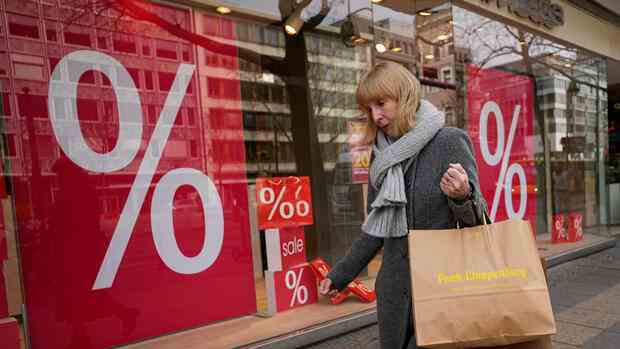The price increase in Germany had recently slowed down somewhat.
(Photo: AP)
Frankfurt The inflation rate in Germany in January compared to the same month last year was around 8.7 percent increased. This was announced by the Federal Statistical Office on Thursday based on a preliminary estimate. In December, the inflation rate was 8.6 percent. Most recently, it had steadily decreased since October. Economists had previously assumed a rate of 9.4 percent.
Inflation has long been well above the target set by the European Central Bank (ECB), which is aiming for a price increase of two percent in the euro area in the medium term. In the past week, the central bank raised the key interest rate again and signaled another step for March. Then she wants to reassess the situation. Economists point out that the composition of inflation has recently changed. Second-round effects, i.e. price increases as a reaction to earlier cost increases, are playing an increasingly important role.
According to the chief economist at KfW, Fritzi Köhler-Geib, it is “too early to give the all-clear”. Inflation has spread across the economy. Therefore, “decisive and robust action by the ECB is also required in the coming months”. Carsten Brzeski, economist at the Dutch bank ING, assumes that the inflation rate in Germany has peaked. However, the extent to which the price increase will now weaken is “highly uncertain”.
The slight increase in inflation in January was due, among other things, to the fact that the federal government took on the down payments for gas and district heating in December, which temporarily dampened inflation. The elimination of this effect has now led to an increase. From March, however, the state price brake for electricity and gas should take effect, which should push down inflation.
Brzeski assumes that government aid to curb energy prices and statistical effects will lead to a decline in the inflation rate in the coming months.
Firms pass on higher costs
There are currently two opposing effects. On the one hand, energy prices are tending to fall. On the other hand, the past increase in the price of electricity, gas and petrol has led to cost increases for many companies. Companies are now increasingly passing these higher costs on to consumers through price increases. As a result, prices are increasing across the board – across all classes of goods. For example, higher kerosene costs drive up prices for air travel or higher heating costs drive up prices in the catering trade.
Added to this is stronger wage dynamics. Trade unions are increasingly demanding higher wages with reference to the higher cost of living. This translates more and more into the price level. ECB chief economist Philip Lane wrote in a blog post late last year that wages would be “the primary driver of inflation over the next few years.”
The broadening of the price increase is particularly evident in core inflation. In this consideration, the prices for energy and food, which are particularly susceptible to fluctuations, are eliminated. At 5.2 percent, core inflation in the euro area is currently at its highest level since monetary union began. The Federal Statistical Office does not report core inflation separately for Germany. But the development should be similar. Central banks pay close attention to core inflation because it is considered a good indicator of the medium-term inflation trend.
ING economist Brzeski expects that the ECB will base its further monetary policy decisions heavily on core inflation. “As long as core inflation remains stubbornly high, the ECB will keep raising rates and not think for a second about future rate cuts.”
Further interest rate developments in the euro area
From his point of view, the decisive factor for the course of the ECB beyond March is whether it then waits until the effects of the tighter monetary policy become apparent, or whether it continues to raise interest rates until core inflation also falls significantly. “In the first case, the ECB could consider pausing its rate hike cycle and raising rates again at the June meeting. In the second case, it would continue to hike interest rates at each meeting, possibly by a smaller 25 basis points.”
The publication of the German inflation figures was originally planned for Tuesday of last week. However, the date had to be postponed due to a technical problem. The inflation figures for the euro area from Wednesday last week therefore did not contain any current values for Germany. Overall, the inflation rate for the euro area in January could now be somewhat higher than initially assumed. Commerzbank expects that it will have to be corrected slightly from 8.5 to 8.6 percent.
More: Inflation in the euro area is falling sharply – what a look at core inflation reveals
